
Building a Beautiful City
Creating an Ideal Life









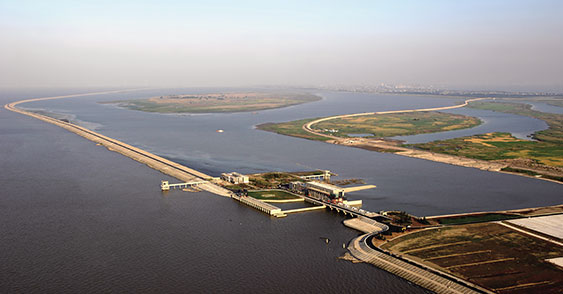
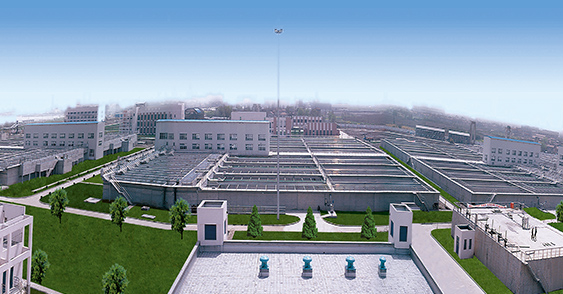
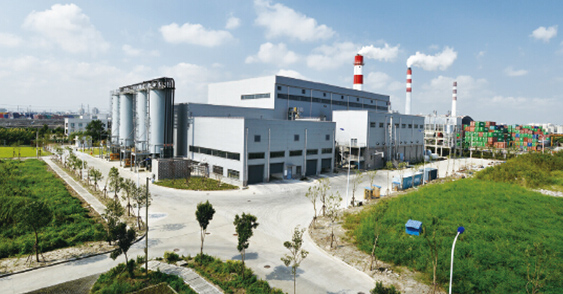
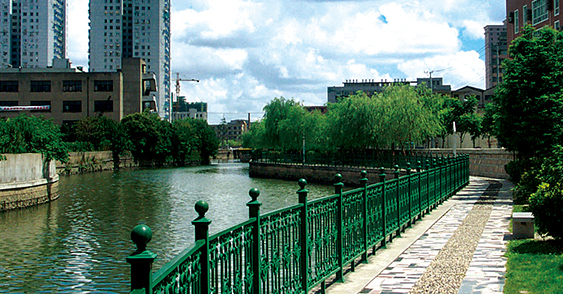
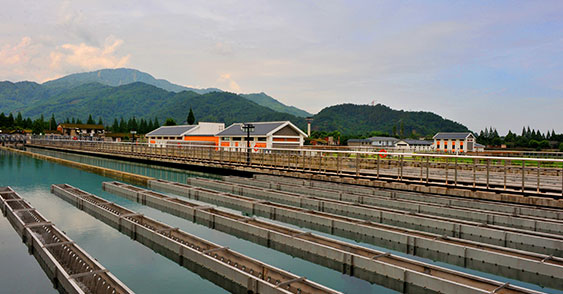

Business sector: Water conservancy
Location: Shanghai
Commencement time: July 2021
Participation mode: Engineering procurement construction
Channel improvement of Chuangxin River in Zhangjiabang Wedge Green Belt (Cuibai Road - Niuqiao Port) and Niuqiao Port (Majiabang - Guanglan Road) is located in Jingang Road of Pudong New Area. The improvement center covers a total length of 1,152 m, among which the length of channel to be improved in the Chuangxin River is 529.2 m. The reach starts from Cuibai Road in the north and ends at Niuqiao Port in the south. The length of channel to be improved in Niuqiao Port is 622.8 m, which starts from Majiabang and ends at Guanglan Road. In this project, STEC constructed about 2, 300-meter revetment, 3,000-meter flood control channel and 13,800-square-meter green space.
The improved Chuangxin River in Zhangjiabang Wedge Green Belt and river channel at Niuqiao Port demonstrate the unique landscape charm of ecological banks with their brilliant ecological appearance. Meanwhile, the project can revitalize the regional water systems, create a natural, comfortable and pleasant river landscape, and further improve the regional capacity for flood control, water logging removal, irrigation regulation and storage. It not only enhances the natural environment on the surrounding land but also "refresh" the life of local residents.

Business sector: Water conservancy and water utilities
Location: Shanghai
Commencement time: January, 2018
Participation mode: Engineering procurement construction
Shield tunneling machine specifications: Slurry balance shield tunneling machine with a diameter of 11.73m
Project breakthroughs: Super-deep diaphragm (103 m) and ultra-deep foundation pit (56.6 m)
With a total length of 15.3 km and a water retention capacity of over 700,000 cubic meters, the deep drainage and storage pipeline system engineering of Suzhou River serves as a key link for Shanghai to systematically develop its in-deep underground space for the first time and to construct "sponge city". The capacity of drainage system along the Suzhou River can be promoted from once every year to once every five years after the whole project is completed. In this way, Shanghai can effectively address the once-in-a-century rainfall and basically eliminate the initial rainwater contamination along the Suzhou River. The Miaopu experimental section undertaken by STEC is as long as 1.61 km. The buried depth of the tunnel will be from 42 m to 60 m. In this experimental section, STEC constructed a round shaft foundation pit as deep as 56.6 m, the deepest foundation pit in soft soil in China. Ultra-deep shaft construction technology is becoming the benchmark for similar projects in the future. It will provide referential significance for the future development and utilization of underground space.

Business sector: Water conservancy and water utilities
Location: Shanghai
Commencement time: September, 2021
Participation mode: Engineering procurement construction
The Phase Ⅲ reconstruction and expansion project of Shanghai Songshen Water Environment Purification Co., Ltd. is located on the south of the company, the south side of Tongxin Road and the east side of Beimaojing. The construction contents involve the sewage plant and the pipeline for pump station outside the plant. The sewage plant involves the following tasks: Upgrade and reconstruct Phases I and II, and expand the capacity of Phase Ⅲ; the treatment capacity of Phase I and II is 140,000 m3/d; upgrade and reconstruct the current situation of Phases I and II, and reduce the capacity by 20,000 m3/d; the sewage treatment capacity will be expanded by 80,000 m3/d in Phase Ⅲ. After the reconstruction and expansion, the whole plant will receive new actual processing capacity of 60,000 m3/d, and its total processing capacity will be 200,000 m3/d. This will greatly improve the sewage treatment capacity in Songjiang area. The effluent quality will not be lower than Grade A standard. That is of great significance for the water source protection in the upper reaches of Huangpu River, the local ecological environment protection and the livelihood improvement.

Business sector: Water conservancy and water utilities
Location: Shanghai
Commencement time: December, 2020
Participation mode: Engineering procurement construction
Project breakthroughs: In this project, STEC applied the prefabrication and assembly technology on large scale and in large volume for the first time into the field of water utilities engineering. A total of 2,488 prefabricated components were adopted, with a maximum height of about 10.12 m and the heaviest weight of 31.13 tons.
Located at the plant with a processing capacity of 500,000 m3/d on the west side of Zhuyuan, Bid ZYSQ 1.3 for Phase IV project of Zhuyuan Sewage Treatment Plant mainly include the following tasks: Construct a new AAO biological reaction tank with a capacity of 500,000 m³, a horizontal sedimentation tank and other buildings / structures; adopt the five-axis mixing pile, the composite steel pipe pile through PC construction method, the UHPC ultra-high performance concrete, and other emerging technologies. In this project, STEC applied the prefabrication and assembly technology on large scale and in large volume for the first time into the field of water utilities engineering. While ensuring the project quality and controlling the project risk, STEC also accumulated important experience for the engineering application of prefabrication technology into the future water utility industry.
Since the commencement, the project department has been awarded many honors, such as Shanghai Civilized Construction Site, Shanghai Green Model Construction Site, Shanghai Five-star Construction Site, Feature Project in Practical Achievements Competition among Major Projects in Shanghai, Excellent Team, etc.

Business sector: Water conservancy and water utilities
Location: Shanghai
Commencement time: May, 2022
Participation mode: Engineering procurement construction
Shield tunneling machine specifications: φ3000 Slurry balance shield tunneling machine
Project breakthroughs: Segmental hoisting construction and slurry wall stability control for the super-deep diaphragm under complex environment.
The bid TP1.3 for initial rainwater regulation project of Taopu Sewage Treatment Plant mainly involves the rainwater collection pipeline system on the east side of Zhenjiang Village and at Zhenguang Village, which adopt the construction technologies of shield tunneling method and pipe jacking method.
All of the work shafts in this project are located at the intersections of municipal roads, and surrounded by many communities, busy commercial zones, large traffic flow and complex pipelines. In order to minimize the impact on surroundings, STEC optimized the construction technology and well structure. The project department actively connected with the local stakeholders, optimized the construction site and traffic organization, and substantially reduced the road area occupied by each shaft; the project department also canceled one pipe jacking shaft and two inspection shafts. That eases the surrounding traffic pressure and provides a reliable guarantee for orderly operation of Shanghai Municipality.

Business sector: Water conservancy and water utilities
Location: Yueyang City of Hunan Province
Commencement time: March, 2021
Participation mode: PPP project
Project breakthroughs: With a total investment of CNY 701.2 million yuan, the project, upon its completion, will provide a largest water supply plant with a capacity of 100,000 m³/d for Xiangyin people. It will supply high-quality production and living water for 300,000 people in the urban and southern areas.
The project sees a total investment of about CNY 701 million yuan. Its main construction contents include water intake engineering, water distribution network and water purification plant project. Its water source is located in the main stream of Xiangjiang River at Wanhe Village in Jinghe Township, with a construction length of 34.73 km and a water supply capacity of 100,000 m³/d.
Since the full commencement of Xiangyin Water Supply Plant project on March 6th, 2021, the project team confronted many difficulties, such as large workload, multiple units and tight construction period. They deployed the backbone, remained on the construction site, and successively overcame a series of difficult nodes, such as temporary land acquisition, river crossing, house demolition and relocation, and operation under high-voltage power lines.Upon its operation, the project will comprehensively increase the water supply quality and capacity in urban and rural areas of Xiangyin, promote the penetration rate of rural tap water, and enhance the weak link in drinking water facilities of Xiangxian County. The project will also reinforce the ability to ensure safe drinking water so that 400,000 urban and rural residents in Xiangyin can drink safe water. As a key livelihood project in the urban and rural water supply integration strategy, the project will play a crucial role in coordinating urban and rural development and accelerating rural revitalization in Xiangyin.

Business sector: Water conservancy and water utilities — Channel improvement
Location: Shanghai
Commencement time: December 23rd, 2021
Participation mode: Engineering procurement construction
The 2021 comprehensive small watershed improvement project for clean eco-system in Huinan Town involves five aspects, namely river and lake system treatment, non-point source contamination control, comprehensive prevention and control of soil and water loss, ecological restoration, and living environment improvement. It mainly covers 80 reaches of river courses in Huinan Xiaohuangpu and Laogang River, 10 groups and 1 tributary in Yuandong, 5 groups and 1 tributary in Yuandong, etc.
The project team adopted water reoxygenation technology to aerate the river course. By improving the ecological environment in the local waters, the team restored the aerobic microbial community and thus ensured the survival of plankton and fish. By virtue of the biological seine technology and the principle of biological pollution control, plants were able to absorb nutrients in the water and to form biofilms to purify water. The team adopted biological seine as a framework to control the growth area of plants so as to avoid the secondary contamination caused by floating plants growing uncontrollably in the water. They employed a plant-floating bed technique, and planted aquatic plants, such as reeds, on the water surface. Those plants are effective in suppressing phytoplankton, improving water transparency, and lowering COD. While purifying water, they can create habitats for birds, fish and other living beings, and improving the landscape.
The comprehensive small watershed improvement project for clean eco-system works as an important basic project for the local government to implement the rural revitalization strategy. It is of great significance to prevent and control soil erosion, promote ecological restoration and protection of rivers and lakes, improve overall agricultural productivity, facilitate the development in green industry, and construct the rural development pattern of harmonious co-existence between man and nature.

Business sector: Water conservancy and water utilities
Location: Shanghai
Commencement time: January 2021
Participation mode: Construction
The sewage connection project between Zhuyuan and Bailong Port involves a new 19-km inter-plant pipeline with a capacity of 800,000 m3/d and two new terminal lift pump stations. The project connects the Bailong Port Sewage Treatment Plant and Zhuyuan Sewage Treatment Plant via pipeline and pump station so as to realize the complementary capacity between sewage treatment facilities in this region. The project, upon its completion, can connect two sewage treatment systems in Zhuyuan and Bailong Port. It can play multiple functions, such as cross-area emergency dispatch and water allocation, and enhance the functional resilience of sewage transmission and treatment system.
In the sewage connection project ZB1.2 (pipeline engineering) between Zhuyuan and Bailong Port, a new pipeline of 9,142 m was newly constructed. The longest jacking path is 1,057.5 m. The project penetrates 11 bridges, 2 high-pressure gas pipes, 2 overpasses in Gaodong, 1 water pipe at Qingcaosha and 1 aviation gas pipe. During the jacking process, the advanced non-constant flow simulation technology with full conservation of mass was adopted to overcome the technical difficulty in intermittent operation of gas-liquid two-phase flow. Simultaneously, the pipeline structure health monitoring system was used to conduct on-line monitoring for pipelines with large diameter and long conveyance distance so that the pipeline structure status can be perceived accurately.

Business Section:Water Treatment
Location:Shanghai
Project Completion Date:10, 2010
Participating Mode:Design + Build
Project’s Scale:Water Supply Reaching 719 Cubic Meters Per Day
Shanghai Qingcaosha Reservoir Raw Water Project is a municipal engineering project of the 11th five-year—plan. It consists of three main projects that are reservoir and water intake pump gate, pipeline for raw water of Yangtze River, terrestrial waterlines and pressure pump station. It is a huge urban water supply project. Under the process of design and construction, STEC made impressive achievement to economize on land and water by adopting such innovative technologies as pipeline series booster, pipe jacking curve, anticorrosion steel pipe combination and pipeline series of water hammer. STEC also overcame difficulties during the construction, such as ultra-deep foundation pit, transportation, ventilation and precision measurement of ultra-long distance. The project also managed to cross under tunnels, rivers, houses and maglev which is already in operation. The project won the National Gold Cup for Municipal Engineering Project, the National Gold Medal for Quality Project, the National Customer Satisfaction Project, Shanghai Safe Construction Site, Shanghai Civilized Construction site and Shanghai Environmental-Friendly Construction Site. Shanghai Qingcaosha Reservoir Raw Water Project is a major project to solve Shanghai citizens’ drinking water problems. The water supply area covers 8 districts including Yangpu, Hongkou, Zhabei, Huangpu, Jing’an, Changning, Putuo, and Xuhui, with a scale of 719 cubic meters per day, benefiting 11.5 million people according to the design. After the establishment of the raw water project, the raw water supply system of Shanghai will form a stable pattern of “two parallel rivers and three water sources” by relying on the upstream of Huangpu River, Chenhang reservoir at the mouth of Yangtze River and Qingcaosha raw water supply, thus solving three main difficulties in terms of the total water supply, the quality of drinking water and the safety of water supply in Shanghai.

Business Section:Water Treatment
Location:Shanghai
Project Completion Date:06, 2010
Participating Mode:Design
Project’s Scale:Handle 170 Cubic Meters of Sewage Per Day
Shanghai Zhuyuan No.1 Sewage Treatment Plant is located inside Zhuyuan Sewage Treatment Plant in Gaodong Town, Pudong New District, covering an area of 500 mu. It is an extension project of the first phase project of Suzhou Creek’s integrated treatment, mainly dealing with domestic sewage and combined sewage in Suzhou Creek, Putuo, Changning, Jing’an, Zhabei as well as partial areas in Huangpu, Hongkou, Yangpu, Pudong and Waigaoqiao, benefiting approximately 2.35 million people. The Shanghai Zhuyuan No.1 Sewage Plant discharges treated water flow into Yangtze River, twice the amount of Suzhou Creek, designed to treat 1.7 million tons of sewage per day, accounting for nearly one third of the whole city’s use. It was the largest modernized sewage treatment plant in Asia upon its completion. In 2004 its treatment of sewage was level 1 and in 2010 it upgraded to level 2 which meant biological treatment. After the establishment of this plant, the entire water environment of the city was greatly improved, and the plant not only played an important role in sewage treatment, water quality maintanence and ecological balance, but also was instrumental in improving the investment environment in Pudong New District and promoting the sustainable development of Pudong’s regional economy.

Business Section:Water Treatment
Location:Shanghai
Project Completion Date:07, 2014
Participating Mode:Design
Project’s Scale:Handle 300 Tons of Sludge Per Day
Shanghai Zhuyuan sludge treatment project, the fourth round of a three-year environmental protection plan and the World Bank loan project, is mainly located within the planning Zhuyuan sludge plant in Waigaoqiao area, Shanghai Pudong New District. It mainly receives and disposes of dewatered sludge from four sludge treatment plants, namely plant one, plant two, Quyang and Sitang in Shanghai Zhuyuan after it was established. It is the largest project with the counterpart technology in Asia Pacific region, and its treatment quantity accounting for a quarter of total sludge amount in Shanghai, and employs the advanced state-of-art “half-dry + incineration” technology. Incineration gas purification employs the technology of “electrostatic precipitator + bag filter +scrubber”, burying the flying ashes into the old harbor after incineration in the short term and utilizing the disposed building materials in the long term, which will guarantee the stability, reduction, reuse and recycle of sludge in Zhuyuan sludge treatment plant after the whole project goes into operation. Shanghai Zhuyuan sludge treatment project solved the difficulty of “sludge around the city”, finding out a way to treat sludge instead of burying it away.

Business Section:Water Treatment
Location:Shanghai
Project Completion Date:2008
Participating Mode:Design
Project’s Scale:Handle 30 Cubic Meters of Sewage Per Day
Shanghai Suzhou Creek Environmental Integrated Improvement Project overcame the difficulty of river closure for dry weather flow in the middle and lower reaches of Suzhou Creek and closed the gaps in the river closure project dealing with direct sewage discharge. The river closure project in the middle and lower reaches involved roughly 10 administrative districts including Jiading, Putuo. The dry weather sewage flow of direct discharge for river closure reaches 30 cubic meters per day. This project is divided into three phases of establishment and improvement of discharge system. The service area of the first phase of the project, tributary sewage for river closure in Suzhou Creek, occupies about 230 square meters, covering 61 discharge system or land parcels. This project effectively controlled and collected sewage produced by the pollution source and decreased the pollution burden that the tributary laid on the mainstream of Suzhou Creek through the large-scale utilization of deodorization techniques in pump stations. The second phase of the project is an important part of water treatment in the latest round of environmental protection plan. The service area occupies 525 square meters. It combined regional planning, built and improved municipal sewage collection system, improved sewage closure facility which offered a path for sewage treatment in rural areas. It built 10 sewage treatment stations, 2 sewage closure facilities, and about 112-kilometer-long rain sewage pipes of which the total investment was 1.08 billion yuan. The third phase of the project covers an area of 525 cubic meters including establishing and improving the discharge system, collecting inland river sewage through drainage pump stations, and rainwater pump station with split-flow rainwater system in charge of river closure for dry weather sewage, involving 20 drainage water systems. It built a 51-kilometer rainwater sewage pipe whose flood and water-logging control capability is 33 cubic meters per second and 3 new closure facilities for dry weather sewage of which the total investment was about 1 billion yuan. The first-stage project won the third prize of National Outstanding Projects in Survey and Design. The second-stage project won the second prize of National Outstanding Projects in Survey and Design. And the third-stage project’s treatment technology won the third prize of Shanghai Scientific and Technological Progress Award in 2007.

Business Section:Water Treatment
Location:Dujiangyan, Sichuan
Project Completion Date:01, 2010
Participating Mode:Managing Contractor
Project’s Scale:Handle 40,000 Tons of Sewage Per Day
As Shanghai began to assist counterpart city Dujiangyan for the disaster rehabilitation work, some major infrastructure’s construction got under way. After helping to build over 8,300 prefabricated houses in Mianyang city, STEC began to assist Dujiangyan City immediately, supporting the building of two sewage treatment plants in Mount Qingcheng, Dujiangyan City. Dujiangyan Sewage Treatment Plant, located in Mount Qingcheng world cultural heritage site, is the first sewage treatment project in a scenic spot in Chengdu. The project consists of A and B sewage plants, plant A located at the sixth group, Daguan Town in Mount Qingcheng, Dujiangyan City, covering an area of 39.27mu while plant B located at the first group, Puyang town in Dujiangyan city, covering an area of 63.98mu. The project consists of prefabrication, biological treatment structures, affiliated facilities and partial sewage treatment project. On the design of sewage plant, with the professional help of the STEC’s design institute, we chose the best alternative. In terms of the construction, we selected the most talented staff to construct the sewage treatment plant, which became a quality project in the disaster area, and won unanimous compliments. After the establishment of the sewage treatment plant in Mount Qingcheng, its capability of treating sewage was 40,000 tons per day. The sewage after treatment meets the national highest discharge standard: Class A, Level 1, which can not only be used in agricultural irrigation and daily water supply, but also in breeding fish. This project once won the Mongolia Construction Award in Shanghai.
STEC 版权所有 沪ICP备15043468号-3

沪公网安备 31010402005457号
沪公网安备 31010402005457号

